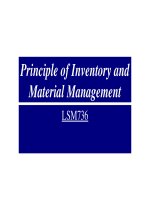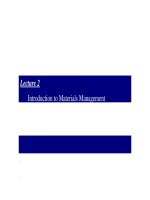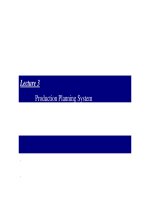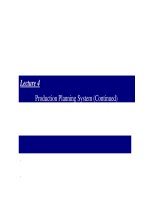Lecture Principle of inventory and material management - Lecture 29
Bạn đang xem bản rút gọn của tài liệu. Xem và tải ngay bản đầy đủ của tài liệu tại đây (599.14 KB, 47 trang )
Lecture 29
Total Quality Management
Books
•
Introduction to Materials Management, Sixth Edition, J. R. Tony Arnold, P.E., CFPIM, CIRM, Fleming
College, Emeritus, Stephen N. Chapman, Ph.D., CFPIM, North Carolina State University, Lloyd M.
Clive, P.E., CFPIM, Fleming College
•
Operations Management for Competitive Advantage, 11th Edition, by Chase, Jacobs, and Aquilano, 2005,
N.Y.: McGrawHill/Irwin.
•
Operations Management, 11/E, Jay Heizer, Texas Lutheran University, Barry Render, Graduate School of
Business, Rollins College, Prentice Hall
Objectives
•
•
•
•
•
•
•
•
•
•
•
Why quality is important
What is quality
Dimensions of Quality
Why improve quality
Statistical quality control
Understanding variations
Statistical process control
Process capability
Three sigma vs. six sigma
Process control
Data types
Orlando Utilities Commission
Maintenance of power generating plants
þ
Every year each plant is taken off-line for 1-3
weeks maintenance
þ
Every three years each plant is taken off-line
for 6-8 weeks for complete overhaul and
turbine inspection
þ
Each overhaul has 1,800 tasks and requires
72,000 labor hours
þ
OUC performs over 12,000 maintenance
tasks each year
þ
Orlando Utilities Commission
Every day a plant is down costs OUC
$110,000
þ
Unexpected outages cost between $350,000
and $600,000 per day
þ
Preventive maintenance discovered a
cracked rotor blade which could have
destroyed a $27 million piece of
equipment
þ
Why Quality is Important
❏
❏
❏
❏
Costs and market share
Company’s reputation
Product liability
International implications
What is Quality?
•
•
•
•
•
Conformance to requirements?
Zero defects?
Fitness for use?
Consistency?
“I can’t define it, but I know it when I
see it”?
Garvin’s 8 Dimensions of Quality
Dimension Meaning
Performance
Primary operating characteristics.
Features
Secondary operating characteristics, added
touches.
Reliability Extent of failure free operation.
Durability Amount of use before replacement is
preferable to repair.
Consistency Uniformity around a target
Serviceability Resolution of problems and complaints.
Aesthetics Subjective characteristics that relate to senses.
Perceived Quality Indirect measures or inferences: reputation.
What is Quality?
Quality means user satisfaction: that
goods and services satisfy the needs and
expectations of the user.
Arnold
Why Improve Quality?
Quality Chain Reaction
Improve Quality
Costs decrease because of less rework,
fewer mistakes, fewer delays, snags;
better use of machine-time and materials
Productivity improves
Capture market with better quality and lower price
Stay in business
Provide jobs and more jobs
Two Ways to Improve Quality
Improving Quality
Inspection of
Product
Improvement of
Process
As Quality Improves
As Quality Improves
Productivity Declines
Productivity Increases
Sources of Improvement
Control
Chart:
Required
Action:
Responsibility:
Common
Causes
Special
Causes
Change the
Process
Fix the
Process
Management
(94%)
Workers
(6%)
Statistical Quality Control:Process Definition
•
Process: “A ‘process’ is any set of conditions, or set of causes,
which work together to produce a given result. In its narrowest
sense the term ‘process’ refers to the operation of a single cause. In
its broadest sense it may refer to the operation of a very
complicated ‘cause system.’
Reference: Statistical Quality Control Handbook, Western Electric
Statistical Quality Control
•
Statistical: With the help of numbers or data
•
Quality: we study the characteristics of our process
•
Control: In order to make it behave the way we want it to
behave.
Reference: Statistical Quality Control Handbook, Western Electric
Understanding Variation
•
•
•
Variation exists in everything
Understanding variation is the key to improving
quality
Two Kinds of Variation
–
–
Chance variation
Assignable variation
Cause and Effect Diagrams
Materials
Methods
Measurement
Process Doc.
PM
Training
Machines
Manpower
Desired Effect
or Undesired
Effect
Motivation
Environment
SPC Assignable Causes
The operational definition of assignable variation is
variation that causes outofcontrol points on a control
chart.
Statistical Quality Control: Natural Patterns or
Variations
Natural patterns exhibit the following characteristics:
•
•
•
Most of the points are near the centerline.
A few points spread out and approach the control limits.
None (or only on rare occasions) of the points exceeds the control
limits.
Reference: Statistical Quality Control Handbook, Western Electric
Statistical Quality Control
Unnatural Patterns or Variations
Unnatural patterns exhibit the following characteristics:
•
•
•
Absence of points near the centerline produces a pattern known as a
“mixture.”
Absence of points near the control limits produces an unnatural
pattern known as “stratification.”
Presence of points outside of the control limits produces an
unnatural pattern known as “instability.”
Reference: Statistical Quality Control Handbook, Western Electric
Statistical Quality Control
Tests for Unnatural Patterns
•
Instability
–
–
–
–
•
A single point falls outside of the 3 sigma control limits.
Two out of three successive points fall in the outer one third of the control
limits.
Four out of five successive points fall in the outer two thirds of the control
limits.
Eight successive points fall on one side of the centerline.
Systematic variable
–
A long series of points are high, low, high, low without interruption.
Reference: Statistical Quality Control Handbook, Western Electric
Statistical Process Control (SPC)
•
•
Chance variations are the many sources of
variation within a process that is in statistical
control. They behave like a constant system of
random chance causes.
If only natural causes of variation are present, the
output of a process forms a distribution that is
stable over time and is predictable.
Statistical Process Control (SPC)
•
•
Assignable variation in a process can be traced to
a specific reason.
✏ Machine wear
✏ Misadjusted equipment
✏ Fatigued or untrained workers
If assignable causes of variation are present, the
process output is not stable over time and is not
predictable.
Statistical Process Control
Why use averages?
•
•
To create a normal distribution
Averages are more sensitive to change than
individuals
The Process (2 of 2)
•
The distribution of a process’ output has a mean, ,
and a standard deviation, ; it can have a wide variety
of shapes
Process
distribution
Mean
Process Capability (1 of 3)
•
When selecting a process to perform an operation, the
inherent variability of process output should be
compared to the range or tolerances allowed by the
designer’s specifications









